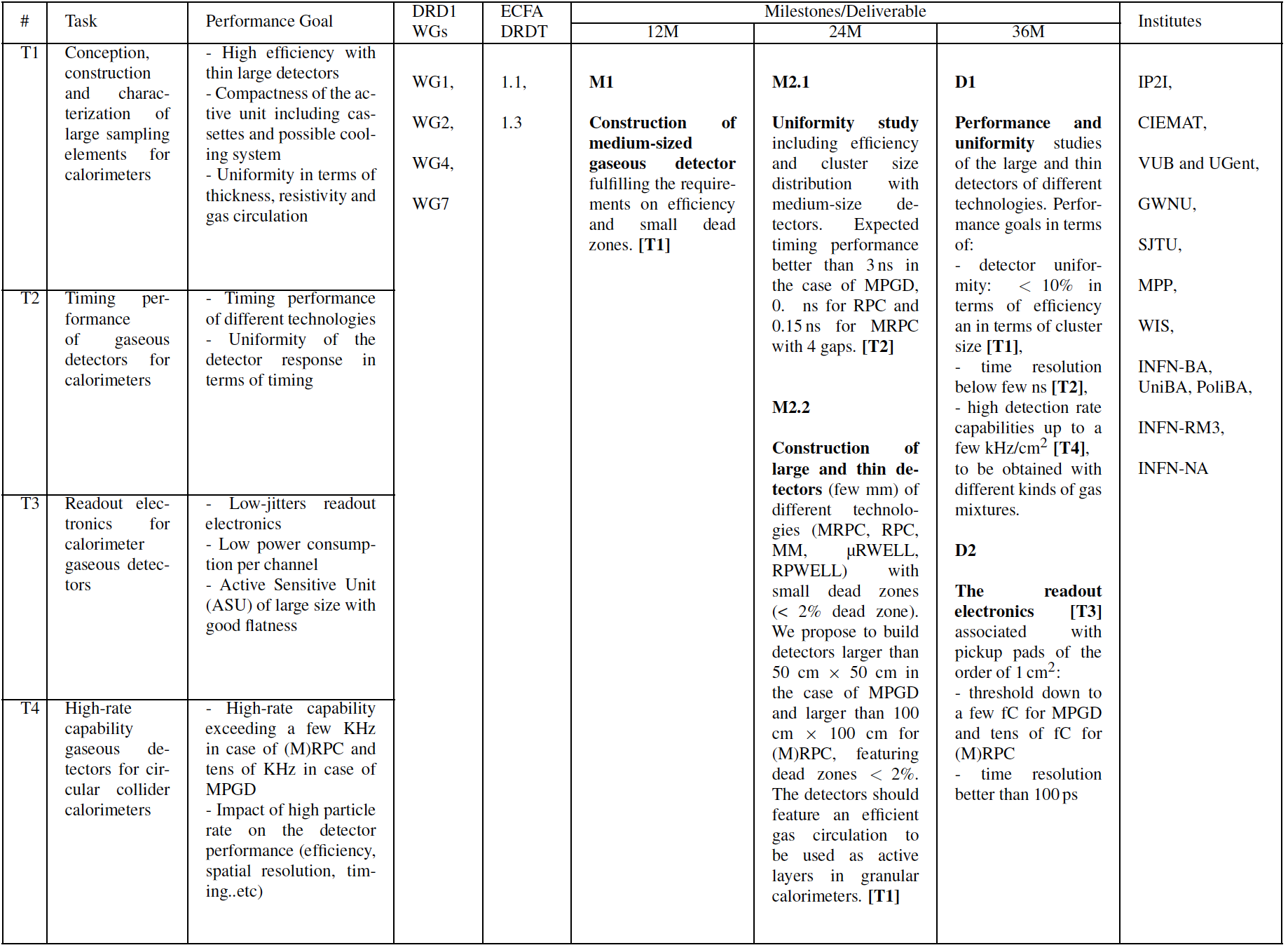Calorimetry
WP Leader:
• Imad Laktineh
Contact: DRD1-WP5-leaders@cern.ch
Participating institutes:
Institut de la physique des 2 infinis (IP2I), Centro de Investigaciones Energéticas, Medioambientales y Tecnológicas (CIEMAT), Vrije Universiteit Brussel (VUB), Gangneung-Wonju National University (GWNU), Shanghai Jiao Tong University (SJTU), Max-Planck Institute for Physics (MPP), Weizmann Institute of Science (WIS), Bari INFN & University (INFN-ba), ROME3 University (ROME3), Naples INFN (INFN-Na)
DESCRIPTION OF THE WORK PACKAGE
Gaseous detectors have been playing an important role in sampling calorimeters since the birth of this kind of instruments. The possibility to produce large area detectors at affordable cost but still with excellent efficiency and high spatial precision make of them a choice of reference. Although many sampling calorimeters of the LHC experiments have opted for scintillators-based active media, gaseous detectors are being proposed again to equip future sampling calorimeters that use the Particle Flow Algorithm (PFA) concept. The latter requires the different detector systems and in particular the calorimeters to be highly granular. Contrary to other technologies, the granularity of gaseous detectors can be very fine thanks to the small extension of the avalanches produced by the charged particles crossing them. Another important feature of the gaseous detectors used in sampling calorimeters is their capability to provide excellent efficiency with a thickness of a few mm. This represents an important asset since the PFA-based calorimeters are required to be enclosed in a magnetic field implying that a thinner active medium corresponds to lower cost.
Several concepts of gaseous detectors were proposed to equip the to equip the sampling elements of hadronic calorimeters for experiments of the future colliders. Large prototypes of Digital and Semi-Digital Hadronic calorimeters were built and successfully operated using RPC layers of a size up to 1 m x 1 m equipped with embedded 1 threshold or 3-threshold digital readout electronics. These prototypes were originally proposed for the International Linear Collider (ILC).
A similar but smaller system with a few 50 cm x 50 cm MicroMegas and RPWELL sampling elements was built and characterized, demonstrating good performance.
Other technologies like µRWELL have also very interesting features that allow them to be excellent candidate to be active media in future calorimeters.
TASKS AND DELIVERABLES
To completely validate gaseous calorimeters for future Higgs factory for both linear and circular colliders further R&D are needed. Here after the most important R&D tasks we propose in this WP:
Task1: Conception, construction and characterization of large sampling elements for calorimeters
Large and thin gaseous detectors are needed for future calorimeters. However, one needs to ensure that the response of such detectors is uniform in terms of efficiency and particle cluster size. The two previous are used to reconstruct the energy when binary or multi-threshold readout is used. The gaseous detectors need thus to be conceived and built having in mind such a uniformity. To achieve such a uniformity, precise mechanical structure should be adopted. In addition, the gas distribution system of the detectors should enable a uniform renewal of the gas inside the detectors.
Task 2: Timing performance of gaseous detectors for calorimeters
Recent studies have shown that time information could help to separate close-by showers but also to evaluate the contribution of delayed neutrons. Some gaseous detectors can provide excellent time information However a good uniformity of time performance is needed to properly exploit such an interesting feature
Task 3: Readout electronics for calorimeter gaseous detectors
In the two previous cases, readout electronics using pickup pads of the order of 1 cm2 is needed. The electronics should be able to preserve the uniformity of the detector. To achieve this the readout electronics should be equipped with the possibility to correct for possible difference of the channels’ response. Moreover, the electronics should be embedded in the readout board of the sampling element in order to save space. It should also be low-power consumption electronics to reduce the active cooling impact on the pfA-based calorimeters performances.
Task4: High-rate capability gaseous detectors for circular collider calorimeters
For circular colliders where the duty cycle is rather a continuous one resulting in a high particle flux in some regions of the detectors, the gaseous detectors of these regions should be able to withstand high rates.
To achieve the previous goals the groups involved in this development will work together to conceive such gaseous detectors using different technologies like (M)RPC and MPGD suited to be used as active media in future highly granular calorimeters.
List of deliverables:
Deliverable1: Construction of large gaseous detectors for granular calorimeters
Construction of large and thin detectors (of a few mm) of different technologies (MRPC, RPC, MM, µRWELL, RPWELL) with small dead zones (< 2% dead zone). We propose to build detectors larger than 50 cm x 50 cm in the case of MPGD and > larger than 100 cm x 100 cm for (M)RPC. The detectors should feature an efficient gas circulation to be used as active layers in granular calorimeters.
Deliverable2: Report of uniformity study of gaseous detectors for granular calorimeters (M36)
A uniformity study of the previous large and thin detectors of different technologies in terms efficiency, particle cluster size as well as timing with different kinds of gas mixtures using readout electronics associated to pickup pads of the order of 1 cm2
